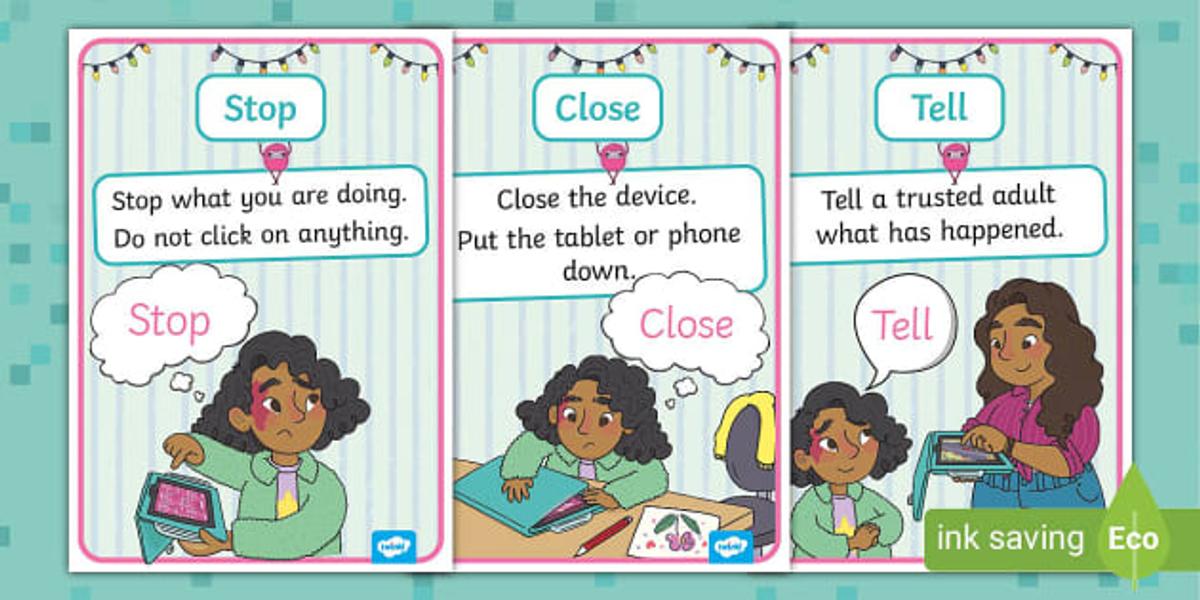eSmart Safety online

As the end of the term approaches, we look forward to having a break.
This can mean that we spend more time on devices, and we need to be vigilant to ensure they are safe.
Along with many positive things we do online, young people may encounter some things which could have a negative effect. This material might include scary texts, violent or scary images, hateful content, and sexual or illegal material.
How might my child encounter negative material?
Children are often curious and may often seek out content themselves. This could be a word they overheard in conversation, read, or on a tv show. Sometimes a friend or older sibling might show them an image, encourage them to look for dangerous things, or they might follow a link designed to look innocent but actually host harmful material, or they might have it sent to them. The majority of the time, children come across this content accidentally, but it is what they do next that is important.
How should I educate my child about online safety?
One of the best strategies is to talk with your family regularly about online risks and safety and how to avoid them, as well as encourage young people to discuss things that disturb or upset them. It’s important to keep an open line of communication about what they do. Talking with your child about their experiences from the first time they go online can be helpful in keeping the lines of communication open for when something disturbs or upsets them.
Showing an interest in their online activity and having relevant conversations about this can help your child feel safe and supported with their online activities. When having these conversations regularly, your child will not feel as though you are trying to invade their privacy when you do ask to discuss or have more difficult conversations around online activity.
Discuss a plan with your child for when they feel uncomfortable or unsure when online. An example can be the Stop, Close, Tell plan. Having regular conversations about who your child’s trusted adults are is important, and it is also important to allow these adults to be others outside of mum or dad.
What should I do if my child tells me they have seen something upsetting or disturbing or are unsure of online?
Young people will react individually to upsetting online content, and how they express their distress will depend on the child’s age and level of development and the content itself. A young person may also act blasé, or they may not understand what they have seen until at a later stage in their development when the effects surface.
Children talk to people they trust and who understand them; this is most likely parents and close family or friends. Knowing what to ask, when, or how to ask can be tricky. If an adult in the child’s life strongly reacts to hearing about the child’s exposure, the child’s negative response may mimic the anxiety and concern of their caregiver even when the young child doesn’t understand the material. When looking to have a chat with your child, consider the following:
· Where you are: Look for a time when your child isn’t going to be distracted by things happening around them
· Keeping it natural: In the car on the way home from school or informally is likely to work better
· Asking open-ended questions: Use questions that invite conversation rather than ones that ask for yes or no answers
· Reserving judgement: Listen and focus on what your child is saying, no matter how hard this might be. Showing an interest in what they are doing makes it easier to have more difficult conversations if a challenge arises.
Once a young person has stopped feeling upset, it can be helpful to provide context for what they have seen. You might like to start by discussing the content of what was viewed, whether it was real or not and how it may have been accessed. The discussion is important even if their attitude is a 'one of ‘no big deal’ at the time. This will help them understand how the material was made, whether it was real, and how the material fits with your family values and provides them with a chance to ask questions.

